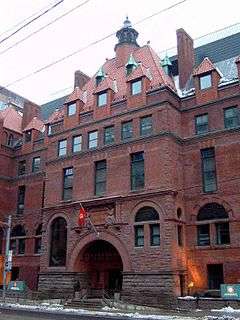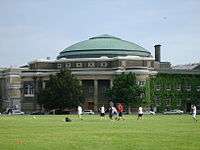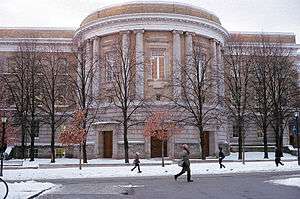Frank Darling (architect)
| Frank Darling | |
|---|---|
 | |
| Born |
February 17, 1850 Scarborough Township, Province of Canada |
| Died |
May 19, 1923 (aged 73) Toronto, Ontario, Canada |
| Nationality | Canadian |
| Alma mater | Trinity College, Toronto |
| Occupation | Architect |
| Awards | Royal Institute of British Architects Gold Medal, 1915 |
| Practice | Toronto |
Frank Darling (February 17, 1850 – May 19, 1923) was a Canadian architect and key player in buildings built in Toronto during the early 20th century. He was a promoter of the Beaux-Arts style.
Early life and education
Born in Scarborough Township in the Province of Canada, Darling was the son of the rector of Scarborough and later of the Church of the Holy Trinity in Toronto. As a boy, he received his general education at Upper Canada College before entering Trinity College, Toronto. He worked briefly as a bank teller before becoming apprenticed to architect Henry Langley from 1866-1870. He studied and trained in England under George Edmund Street between 1870-1873 and then returned to Canada. [1]
Career
Apart from two brief solo periods in the 1870s, he practiced with a series of collaborators:
- Macdougall & Darling from 1874–75
- Darling & Edwards from 1878–79
- Darling & Curry from 1880–91[1]
- Darling, Curry, Sproatt, & Pearson, 1892
- Darling, Sproatt, & Pearson, 1893–96
In 1897 Darling formed the lasting partnership, Pearson and Darling.[1] This firm lasted beyond Darling's death in 1923. The firms in which he was a partnership influenced commercial development in Toronto during the 1910s to 1920s.
Darling was the first Honorary President of the Toronto Beaux-Arts Club, member of the Holt Commission for planning of Ottawa (1913–1915), and was the first Canadian to win the Royal Institute of British Architects Gold Medal in 1915.
Darling died in 1923 and was buried at St. John's Cemetery Norway in Toronto.
Major Works
| Building | Year Completed | Location | Notes | Image |
|---|---|---|---|---|
| Bank of Montreal | 1886 | Northwest corner of Yonge Street and Front Street, Toronto | In the Beaux-Arts style by Frank Darling & S. George Curry. Now home to the Hockey Hall of Fame. | |
| The Toronto Club | 1888 | 107-109 Wellington Street West, Toronto | In the Palladian, Renaissance Revival, and Richardson Romanesque styles by Frank Darling & S. George Curry. | .jpg) |
| Victoria Hospital for Sick Children | 1889-92 | 67 College Street, Toronto | In the Romanesque Revival style by Frank Darling & S. George Curry. |  |
| University of Toronto Faculty of Law Flavelle House | 1902 | 78 Queen's Park, University of Toronto St. George campus, Toronto | Monumental neoclassical residence for industrialist Sir Joseph Flavelle by John A. Pearson & Frank Darling. Now used by the University of Toronto's Faculty of Law. | |
| Convocation Hall | 1907 | 31 King's College Circle, University of Toronto St. George campus, Toronto | Neoclassical domed rotunda by John A. Pearson & Frank Darling. |  |
| University of Toronto Faculty of Applied Science and Engineering Sandford Fleming Building | 1907 | 10 King's College Road, University of Toronto St. George campus, Toronto | In the Neoclassical style by John A. Pearson & Frank Darling. |  |
| South wing of the University of Toronto Sigmund Samuel Building | 1912 | 7 King's College Circle, University of Toronto St. George campus, Toronto | John A. Pearson & Frank Darling. | |
| Arts Building, University of Alberta[2] | 1915 | 11487 89 Avenue, Edmonton, Alberta | In the Neoclassical style by Percy Erskine Nobbs & Frank Darling. |  |
| Toronto General Hospital College Street Wing | 1919 | 101 College Street, Toronto | In the Beaux-Arts style by John A. Pearson & Frank Darling. Now part of the MaRS Discovery District. |  |
For projects after the formation of Darling, S. George Curry, Sproatt, & Pearson in 1892, see Pearson and Darling.
See also
- Pearson and Darling
- Henry Sproatt - partnered with Darling from 1893 to 1896
Notes
- 1 2 3 "Once Upon A City: Creating Toronto’s skyline". Toronto Star, March 27, 2016, Janice Bradbeer.
- ↑ http://dictionaryofarchitectsincanada.org/architects/view/1452
References
- "Frank Darling". Dictionary of Canadian Biography (online ed.). University of Toronto Press. 1979–2016.
- Bank of Montreal Building
- Old Trinity College and Trinity College Gates
- Toronto, No Mean City, by Eric Ross Arthur, Stephen A. Otto
External links
| Wikimedia Commons has media related to Frank Darling. |
- Biographical Dictionary of Architects in Canada 1800-1950
- Historicist: The Lasting Legacy of Darling and Pearson
- Historic Places in Canada